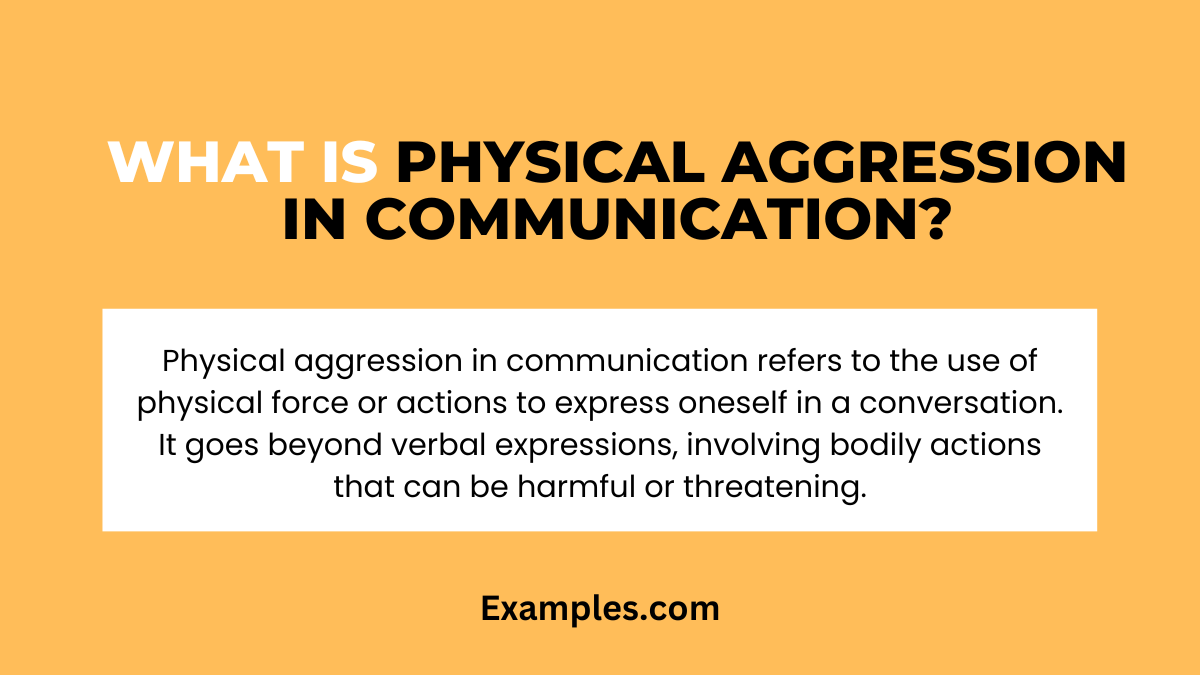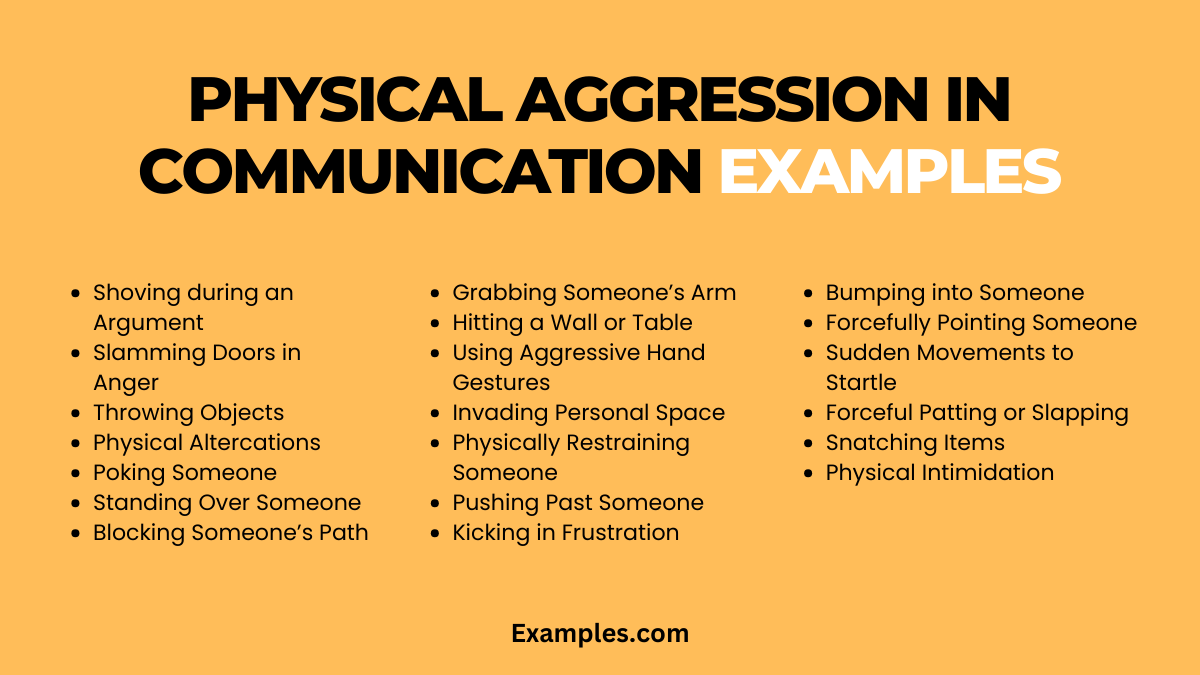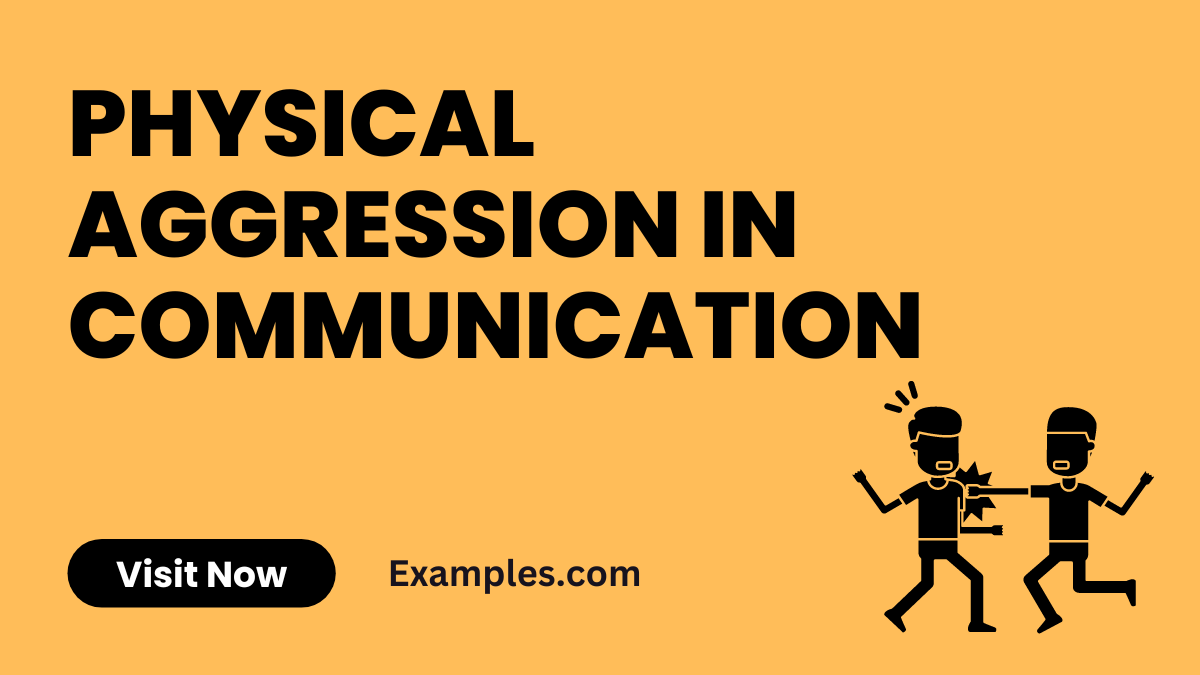19+ Physical Aggression in Communication Examples
Physical Aggression in Communication is a crucial topic that demands attention and understanding. This comprehensive guide delves into the various facets of physical aggression within communicative contexts. It explores real-life examples, showcasing how physical aggression can manifest in interactions and the impact it has on communication dynamics. This guide is designed to provide insights into identifying, understanding, and addressing physical aggression, equipping readers with strategies to manage such situations effectively. It emphasizes the importance of maintaining respectful and non-violent communication, offering practical tips and techniques to navigate complex communicative scenarios where physical aggression might arise.
What is Physical Aggression in Communication?

Physical aggression in communication refers to the use of physical force or actions to express oneself in a conversation. This type of aggression can include behaviors like pushing, hitting, or invading personal space to intimidate or dominate the other person. It goes beyond verbal expressions, involving bodily actions that can be harmful or threatening. Physical aggression is generally seen as a severe form of communication breakdown and is unacceptable in most social and professional settings.
20 Physical Aggression in Communication Examples

Physical aggression in communication refers to behaviors where physical force is used to express oneself or to dominate in an interaction. This type of communication is often detrimental, leading to conflicts and damaging relationships. The following examples showcase various instances where physical aggression is exhibited in communication, each followed by a brief explanation. These examples serve as a cautionary illustration of the negative impact physical aggression can have on both personal and professional interactions.
- Shoving during an argument: In a heated discussion, one individual pushes another in frustration, escalating the situation.
- Slamming doors in anger: Expressing frustration or anger by violently closing doors during or after a conversation.
- Throwing objects during a disagreement: In a moment of anger, someone throws an object, like a book or a phone, to intimidate the other person.
- Physical altercations in a conflict: Escalating verbal arguments to physical fights.
- Poking or jabbing someone to emphasize a point: Using physical touch inappropriately to stress their argument.
- Standing over someone to assert dominance: Using physical presence and posture to intimidate during a conversation.
- Blocking someone’s path during a discussion: Physically preventing someone from leaving a situation to continue an argument.
- Forcefully grabbing someone’s arm: Using physical force to hold someone in place during an interaction.
- Hitting a wall or table to intimidate: Striking inanimate objects to show anger or frustration.
- Using aggressive hand gestures: Expressing oneself with threatening or violent hand movements.
- Invading personal space to threaten: Getting too close to someone in a confrontational manner.
- Physically restraining someone from speaking: Holding someone to prevent them from responding or leaving.
- Pushing past someone aggressively: Physically moving someone out of the way in a forceful manner.
- Kicking something in frustration: Demonstrating anger physically during a conversation.
- Bumping into someone intentionally: Using physical contact to express irritation or anger.
- Forcefully pointing or poking at someone: Using finger-pointing or jabbing motions in a threatening way.
- Sudden movements to startle: Making quick or unexpected movements to intimidate during a discussion.
- Forceful patting or slapping on the back: Overly aggressive physical contact disguised as friendly gestures.
- Snatching items from someone’s hand: Aggressively taking things away to assert control.
- Physical intimidation through posture and stance: Using body language to dominate or threaten during communication.
Physical Aggression in Communication Examples in the Workplace
Physical aggression in the workplace encompasses any form of physical behavior used to intimidate, harm, or exert control. This guide highlights examples where such aggression manifests, impacting workplace safety and employee well-being. Understanding these examples is crucial for creating a safer, more respectful professional environment.
- Slamming doors or objects during a disagreement. – Demonstrates physical aggression used to intimidate during a conflict.
- Standing too close or invading personal space to assert dominance. – Uses physical presence to control or intimidate others.
- Pounding on a desk to emphasize a point. – Shows aggression through intimidating actions rather than constructive dialogue.
- Making threatening gestures towards colleagues. – Non-verbal threats that create a hostile work environment.
- Physically blocking someone’s way during an argument. – Asserts control and intimidation through physical presence.
Physical Aggression in Communication Examples in Relationships
Physical aggression in relationships refers to behaviors where physical actions are used to communicate anger, frustration, or control. Recognizing these behaviors is essential for maintaining healthy and respectful personal relationships.
- Grabbing a partner’s arm during an argument. – Shows aggression through physical control and intimidation.
- Throwing objects in anger during a dispute. – Represents aggression through destructive actions.
- Shoving or pushing during a heated discussion. – Direct physical aggression used to intimidate or control a partner.
- Using aggressive body language, like clenching fists, during conflicts. – Communicates anger and potential threat through body language.
- Blocking exits or doorways to prevent a partner from leaving. – Physical intimidation used to assert control in a situation.
What are the Characteristics of Physical Aggression in Communication?
Physical aggression in communication is characterized by behaviors that are physically intimidating or harmful. Key characteristics include:
- Use of Force: Non-verbal aggression can manifest as physical force, ranging from mild actions like poking or pushing to more severe forms like hitting or striking. These actions are intended to physically intimidate or harm the other person.
- Intimidating Body Language: Aggressive individuals may employ intimidating body language, such as standing too close to the other person, clenching fists, or loom over them. These gestures are designed to convey dominance and provoke fear.
- Destructive Actions: Destructive actions involve behaviors like slamming doors, throwing objects, or damaging property. These actions not only exhibit anger but also create a hostile and intimidating atmosphere.
- Invasion of Personal Space: An aggressor may invade someone’s personal space intentionally to intimidate or exert control. This invasion can make the other person feel trapped or threatened.
- Non-Verbal Threats: Non-verbal threats encompass gestures that imply a threat of physical harm without explicitly stating it. These can include menacing stares, aggressive posturing, or brandishing objects in a threatening manner.
Understanding these characteristics is crucial for recognizing and addressing physical aggression in various communication settings.
How to Deal with Physical Aggression in Communication?
Dealing with physical aggression in communication requires a careful and assertive approach:
- Prioritize Safety: When faced with physical aggression that poses an immediate threat, your first and foremost concern should be personal safety. Quickly assess the situation and, if necessary, remove yourself from harm’s way. In cases of workplace or institutional settings, activate any available safety protocols or alarms to ensure the safety of all individuals involved.
- Stay Calm: Maintaining composure is vital in de-escalating a potentially volatile situation. Avoid reacting with aggression or fear, as this can exacerbate the aggressor’s behavior. Speak calmly and clearly to convey that you are not a threat and that a peaceful resolution is possible.
- Set Clear Boundaries: Communicate firmly and assertively to establish clear boundaries. Let the aggressor know what behaviors are unacceptable and that you expect respect and non-violence. Use straightforward language and maintain eye contact to convey your message effectively.
- Seek Support: In situations where physical aggression persists or escalates, involving a mediator, supervisor, or security personnel may be necessary. These individuals can provide assistance in defusing the situation and ensuring the safety of everyone involved. Don’t hesitate to reach out for help when needed.
- Report Incidents: Documenting and reporting incidents of physical aggression is crucial, especially in workplace or institutional settings. Create a written record detailing the event, including the date, time, location, individuals involved, and a description of what occurred. Reporting ensures that appropriate actions are taken to address the aggression and prevent future incidents.
- Professional Assistance: In severe cases of physical aggression, seeking help from professionals like counselors or law enforcement may be necessary. These professionals are trained to handle challenging situations and can provide guidance, support, and, if needed, legal intervention to ensure safety and resolution.
Effectively dealing with physical aggression involves a balance of assertiveness, safety considerations, and seeking appropriate support.
In conclusion, physical aggression in communication, whether in the workplace or personal relationships, represents a serious concern. It not only undermines safety and respect but also severely impacts the mental and emotional well-being of individuals. Understanding and recognizing these aggressive behaviors are crucial for taking appropriate actions to create a safe and supportive environment. It’s vital to address such issues promptly and effectively to ensure healthy, constructive interactions in all aspects of life.



